A : Poultry farming has definite advantage over live-stock rearing
R : Poultry birds are easy to raise, can be acclimatised to a wide range of climatic conditions, have short life span and are prolific breeders
The correct Answer is:A
Step-by-Step Solution:
1. Understanding the Assertion and Reason:
- The assertion states that "Poultry farming has definite advantages over livestock rearing".
- The reason given is that "Poultry birds are easy to raise, can be acclimatized to a wide range of climatic conditions, have a short lifespan, and are prolific breeders".
2. Defining Poultry Farming and Livestock Rearing:
- Poultry farming involves raising domestic birds such as chickens, turkeys, geese, and ducks primarily for meat and eggs.
- Livestock rearing involves raising larger animals like sheep, pigs, goats, buffalo, and cows for milk and meat production.
3. Comparing Space Requirements:
- Poultry farming requires less space compared to livestock rearing, making it more feasible for small-scale operations.
4. Cost-Effectiveness:
- Poultry birds are generally less expensive to raise than larger livestock animals, contributing to lower operational costs.
5. Lifespan and Returns:
- Poultry birds have a shorter lifespan, which allows for quicker turnover and higher returns in a shorter time frame compared to livestock.
6. Breeding Characteristics:
- Poultry birds are prolific breeders, meaning they can produce a large number of offspring, enhancing profitability.
7. Climatic Adaptability:
- Poultry birds can adapt to a wide range of climatic conditions, making them more versatile for different farming environments.
8. Conclusion:
- Both the assertion and the reason are true. The reason supports the assertion, indicating that poultry farming does indeed have advantages over livestock rearing.
Final Answer:
Both the assertion (A) and the reason (R) are true, and the reason (R) correctly explains the assertion (A).
---
- The assertion states that "Poultry farming has definite advantages over livestock rearing".
- The reason given is that "Poultry birds are easy to raise, can be acclimatized to a wide range of climatic conditions, have a short lifespan, and are prolific breeders".
- Poultry farming involves raising domestic birds such as chickens, turkeys, geese, and ducks primarily for meat and eggs.
- Livestock rearing involves raising larger animals like sheep, pigs, goats, buffalo, and cows for milk and meat production.
- Poultry farming requires less space compared to livestock rearing, making it more feasible for small-scale operations.
- Poultry birds are generally less expensive to raise than larger livestock animals, contributing to lower operational costs.
- Poultry birds have a shorter lifespan, which allows for quicker turnover and higher returns in a shorter time frame compared to livestock.
- Poultry birds are prolific breeders, meaning they can produce a large number of offspring, enhancing profitability.
- Poultry birds can adapt to a wide range of climatic conditions, making them more versatile for different farming environments.
- Both the assertion and the reason are true. The reason supports the assertion, indicating that poultry farming does indeed have advantages over livestock rearing.
Both the assertion (A) and the reason (R) are true, and the reason (R) correctly explains the assertion (A).
Similar Questions
The Physician Assistant Will See You Now
23 The term “paramedics” refers to health care workers who provide routine and clinical services.–––––––––––––––––––––––––––––––––––––––––––––––––––––––––––––––––––––––––––––––––––––––––––––––––––––– While the pressures of an aging population, insurance reforms, and health epidemics have increased demand for care, the supply of physicians is not expected to 24 keep pace.––––––––––– The Association of American Medical Colleges predicts a shortage of over 90,000 physicians by 2020, by 2025, that number could climb to more than 130,000. In some parts of the country, shortages are already a sad fact of life. A 2009 report by the Bureau of Health Professions notes that although a fifth of the US population lives in rural areas, less than a tenth of US physicians serves that population. Because a traditionalist response to the crisis— 25 amping up–––––––––––– medical-college enrollments and expanding physician training programs—is too slow and costly to address the near-term problem, alternatives are being explored. One promising avenue has been greater reliance on physician assistants (PAs).
26 By virtue of 27 there–––––– medical training, PAs can perform many of the jobs traditionally done by doctors, including treating chronic and acute conditions, performing minor 28 surgeries: and––––––––––––––– prescribing some medications. However, although well 29 compensated earning in 2012 a median annual salary of $90,930,––––––––––––––––––––––––––––––––––––––––––––––––––––––––––––––––––––– PAs cost health care providers less than do the physicians who might otherwise undertake these tasks. Moreover, the training period for PAs is markedly shorter than 30 those for–––––––––– physicians—two to three years versus the seven to eleven required for physicians.
Physician assistants already offer vital primary care in many locations. Some 90,000 PAs were employed nationwide in 2012. Over and above their value in partially compensating for the general physician shortage has been their extraordinary contribution to rural health care. A recent review of the scholarly literature by Texas researchers found that PAs lend cost-efficient, widely appreciated services in underserved areas. 31 In addition,––––––––––––– rural-based PAs often provide a broader spectrum of such services than do their urban and suburban counterparts, possibly as a consequence of the limited pool of rural-based physicians.
Increasingly, PAs and other such medical practitioners have become a critical complement to physicians. A 2013 RAND Corporation report estimates that while the number of primary care physicians will increase slowly from 2010 to 2025, the number of physician assistants and nurse-practitioners in primary care will grow at much faster rates. 32 Both by merit and from necessity, PAs are likely to greet more 33 patience than––––––––––––––– ever before.
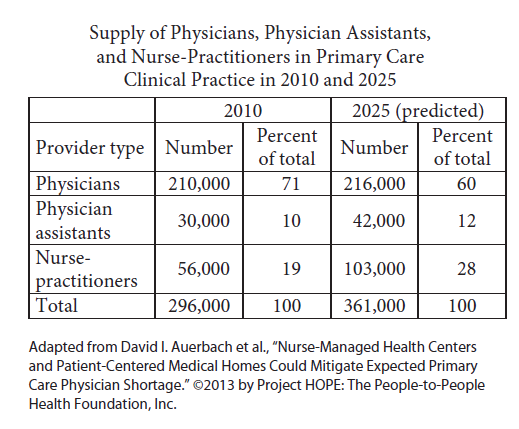 View Solution
View SolutionThe Physician Assistant Will See You Now
23 The term “paramedics” refers to health care workers who provide routine and clinical services.–––––––––––––––––––––––––––––––––––––––––––––––––––––––––––––––––––––––––––––––––––––––––––––––––––––– While the pressures of an aging population, insurance reforms, and health epidemics have increased demand for care, the supply of physicians is not expected to 24 keep pace.––––––––––– The Association of American Medical Colleges predicts a shortage of over 90,000 physicians by 2020, by 2025, that number could climb to more than 130,000. In some parts of the country, shortages are already a sad fact of life. A 2009 report by the Bureau of Health Professions notes that although a fifth of the US population lives in rural areas, less than a tenth of US physicians serves that population. Because a traditionalist response to the crisis— 25 amping up–––––––––––– medical-college enrollments and expanding physician training programs—is too slow and costly to address the near-term problem, alternatives are being explored. One promising avenue has been greater reliance on physician assistants (PAs).
26 By virtue of 27 there–––––– medical training, PAs can perform many of the jobs traditionally done by doctors, including treating chronic and acute conditions, performing minor 28 surgeries: and––––––––––––––– prescribing some medications. However, although well 29 compensated earning in 2012 a median annual salary of $90,930,––––––––––––––––––––––––––––––––––––––––––––––––––––––––––––––––––––– PAs cost health care providers less than do the physicians who might otherwise undertake these tasks. Moreover, the training period for PAs is markedly shorter than 30 those for–––––––––– physicians—two to three years versus the seven to eleven required for physicians.
Physician assistants already offer vital primary care in many locations. Some 90,000 PAs were employed nationwide in 2012. Over and above their value in partially compensating for the general physician shortage has been their extraordinary contribution to rural health care. A recent review of the scholarly literature by Texas researchers found that PAs lend cost-efficient, widely appreciated services in underserved areas. 31 In addition,––––––––––––– rural-based PAs often provide a broader spectrum of such services than do their urban and suburban counterparts, possibly as a consequence of the limited pool of rural-based physicians.
Increasingly, PAs and other such medical practitioners have become a critical complement to physicians. A 2013 RAND Corporation report estimates that while the number of primary care physicians will increase slowly from 2010 to 2025, the number of physician assistants and nurse-practitioners in primary care will grow at much faster rates. 32 Both by merit and from necessity, PAs are likely to greet more 33 patience than––––––––––––––– ever before.
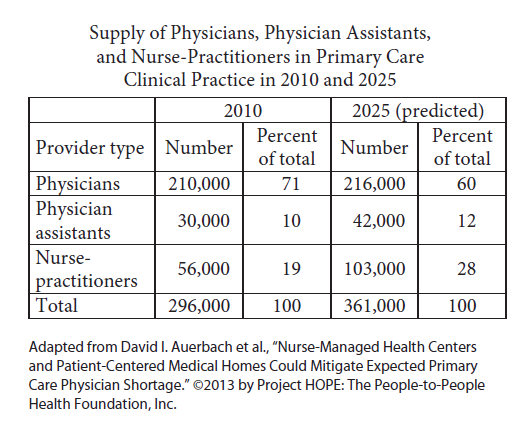 View Solution
View Solution
Knowledge Check
- Question 1 - Select One
The Physician Assistant Will See You Now
23 The term “paramedics” refers to health care workers who provide routine and clinical services.–––––––––––––––––––––––––––––––––––––––––––––––––––––––––––––––––––––––––––––––––––––––––––––––––––––– While the pressures of an aging population, insurance reforms, and health epidemics have increased demand for care, the supply of physicians is not expected to 24 keep pace.––––––––––– The Association of American Medical Colleges predicts a shortage of over 90,000 physicians by 2020, by 2025, that number could climb to more than 130,000. In some parts of the country, shortages are already a sad fact of life. A 2009 report by the Bureau of Health Professions notes that although a fifth of the US population lives in rural areas, less than a tenth of US physicians serves that population. Because a traditionalist response to the crisis— 25 amping up–––––––––––– medical-college enrollments and expanding physician training programs—is too slow and costly to address the near-term problem, alternatives are being explored. One promising avenue has been greater reliance on physician assistants (PAs).
26 By virtue of 27 there–––––– medical training, PAs can perform many of the jobs traditionally done by doctors, including treating chronic and acute conditions, performing minor 28 surgeries: and––––––––––––––– prescribing some medications. However, although well 29 compensated earning in 2012 a median annual salary of $90,930,––––––––––––––––––––––––––––––––––––––––––––––––––––––––––––––––––––– PAs cost health care providers less than do the physicians who might otherwise undertake these tasks. Moreover, the training period for PAs is markedly shorter than 30 those for–––––––––– physicians—two to three years versus the seven to eleven required for physicians.
Physician assistants already offer vital primary care in many locations. Some 90,000 PAs were employed nationwide in 2012. Over and above their value in partially compensating for the general physician shortage has been their extraordinary contribution to rural health care. A recent review of the scholarly literature by Texas researchers found that PAs lend cost-efficient, widely appreciated services in underserved areas. 31 In addition,––––––––––––– rural-based PAs often provide a broader spectrum of such services than do their urban and suburban counterparts, possibly as a consequence of the limited pool of rural-based physicians.
Increasingly, PAs and other such medical practitioners have become a critical complement to physicians. A 2013 RAND Corporation report estimates that while the number of primary care physicians will increase slowly from 2010 to 2025, the number of physician assistants and nurse-practitioners in primary care will grow at much faster rates. 32 Both by merit and from necessity, PAs are likely to greet more 33 patience than––––––––––––––– ever before.
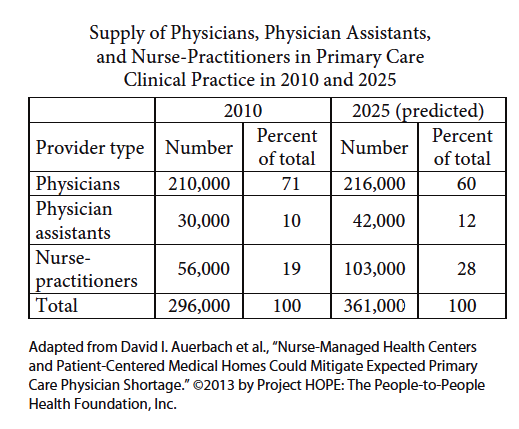 ANO CHANGEBmaintain the tempo.Cget in line.Dmove along.
ANO CHANGEBmaintain the tempo.Cget in line.Dmove along. - Question 2 - Select One
The Physician Assistant Will See You Now
23 The term “paramedics” refers to health care workers who provide routine and clinical services.–––––––––––––––––––––––––––––––––––––––––––––––––––––––––––––––––––––––––––––––––––––––––––––––––––––– While the pressures of an aging population, insurance reforms, and health epidemics have increased demand for care, the supply of physicians is not expected to 24 keep pace.––––––––––– The Association of American Medical Colleges predicts a shortage of over 90,000 physicians by 2020, by 2025, that number could climb to more than 130,000. In some parts of the country, shortages are already a sad fact of life. A 2009 report by the Bureau of Health Professions notes that although a fifth of the US population lives in rural areas, less than a tenth of US physicians serves that population. Because a traditionalist response to the crisis— 25 amping up–––––––––––– medical-college enrollments and expanding physician training programs—is too slow and costly to address the near-term problem, alternatives are being explored. One promising avenue has been greater reliance on physician assistants (PAs).
26 By virtue of 27 there–––––– medical training, PAs can perform many of the jobs traditionally done by doctors, including treating chronic and acute conditions, performing minor 28 surgeries: and––––––––––––––– prescribing some medications. However, although well 29 compensated earning in 2012 a median annual salary of $90,930,––––––––––––––––––––––––––––––––––––––––––––––––––––––––––––––––––––– PAs cost health care providers less than do the physicians who might otherwise undertake these tasks. Moreover, the training period for PAs is markedly shorter than 30 those for–––––––––– physicians—two to three years versus the seven to eleven required for physicians.
Physician assistants already offer vital primary care in many locations. Some 90,000 PAs were employed nationwide in 2012. Over and above their value in partially compensating for the general physician shortage has been their extraordinary contribution to rural health care. A recent review of the scholarly literature by Texas researchers found that PAs lend cost-efficient, widely appreciated services in underserved areas. 31 In addition,––––––––––––– rural-based PAs often provide a broader spectrum of such services than do their urban and suburban counterparts, possibly as a consequence of the limited pool of rural-based physicians.
Increasingly, PAs and other such medical practitioners have become a critical complement to physicians. A 2013 RAND Corporation report estimates that while the number of primary care physicians will increase slowly from 2010 to 2025, the number of physician assistants and nurse-practitioners in primary care will grow at much faster rates. 32 Both by merit and from necessity, PAs are likely to greet more 33 patience than––––––––––––––– ever before.
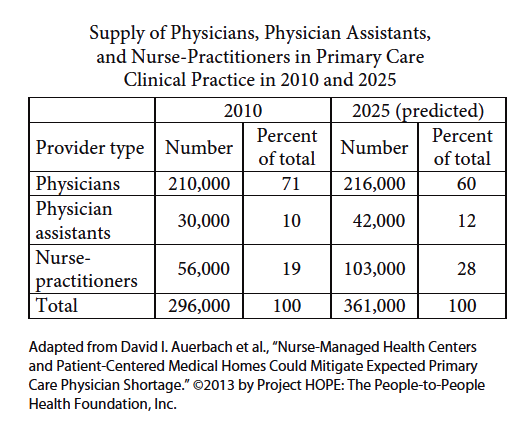 ANO CHANGEBsurgeries, andCsurgeries, and,Dsurgeries, and
ANO CHANGEBsurgeries, andCsurgeries, and,Dsurgeries, and - Question 3 - Select One
The Physician Assistant Will See You Now
23 The term “paramedics” refers to health care workers who provide routine and clinical services.–––––––––––––––––––––––––––––––––––––––––––––––––––––––––––––––––––––––––––––––––––––––––––––––––––––– While the pressures of an aging population, insurance reforms, and health epidemics have increased demand for care, the supply of physicians is not expected to 24 keep pace.––––––––––– The Association of American Medical Colleges predicts a shortage of over 90,000 physicians by 2020, by 2025, that number could climb to more than 130,000. In some parts of the country, shortages are already a sad fact of life. A 2009 report by the Bureau of Health Professions notes that although a fifth of the US population lives in rural areas, less than a tenth of US physicians serves that population. Because a traditionalist response to the crisis— 25 amping up–––––––––––– medical-college enrollments and expanding physician training programs—is too slow and costly to address the near-term problem, alternatives are being explored. One promising avenue has been greater reliance on physician assistants (PAs).
26 By virtue of 27 there–––––– medical training, PAs can perform many of the jobs traditionally done by doctors, including treating chronic and acute conditions, performing minor 28 surgeries: and––––––––––––––– prescribing some medications. However, although well 29 compensated earning in 2012 a median annual salary of $90,930,––––––––––––––––––––––––––––––––––––––––––––––––––––––––––––––––––––– PAs cost health care providers less than do the physicians who might otherwise undertake these tasks. Moreover, the training period for PAs is markedly shorter than 30 those for–––––––––– physicians—two to three years versus the seven to eleven required for physicians.
Physician assistants already offer vital primary care in many locations. Some 90,000 PAs were employed nationwide in 2012. Over and above their value in partially compensating for the general physician shortage has been their extraordinary contribution to rural health care. A recent review of the scholarly literature by Texas researchers found that PAs lend cost-efficient, widely appreciated services in underserved areas. 31 In addition,––––––––––––– rural-based PAs often provide a broader spectrum of such services than do their urban and suburban counterparts, possibly as a consequence of the limited pool of rural-based physicians.
Increasingly, PAs and other such medical practitioners have become a critical complement to physicians. A 2013 RAND Corporation report estimates that while the number of primary care physicians will increase slowly from 2010 to 2025, the number of physician assistants and nurse-practitioners in primary care will grow at much faster rates. 32 Both by merit and from necessity, PAs are likely to greet more 33 patience than––––––––––––––– ever before.

Which choice is the best introduction to the paragraph?ANO CHANGEBFor many Americans, finding a physician is likely to become a growing challenge.CGetting treatment for an illness usually requires seeing either a general practitioner or a specialist.DWorldwide the costs of health care are increasing at an alarming rate.
The Physician Assistant Will See You Now
23 The term “paramedics” refers to health care workers who provide routine and clinical services.–––––––––––––––––––––––––––––––––––––––––––––––––––––––––––––––––––––––––––––––––––––––––––––––––––––– While the pressures of an aging population, insurance reforms, and health epidemics have increased demand for care, the supply of physicians is not expected to 24 keep pace.––––––––––– The Association of American Medical Colleges predicts a shortage of over 90,000 physicians by 2020, by 2025, that number could climb to more than 130,000. In some parts of the country, shortages are already a sad fact of life. A 2009 report by the Bureau of Health Professions notes that although a fifth of the US population lives in rural areas, less than a tenth of US physicians serves that population. Because a traditionalist response to the crisis— 25 amping up–––––––––––– medical-college enrollments and expanding physician training programs—is too slow and costly to address the near-term problem, alternatives are being explored. One promising avenue has been greater reliance on physician assistants (PAs).
26 By virtue of 27 there–––––– medical training, PAs can perform many of the jobs traditionally done by doctors, including treating chronic and acute conditions, performing minor 28 surgeries: and––––––––––––––– prescribing some medications. However, although well 29 compensated earning in 2012 a median annual salary of $90,930,––––––––––––––––––––––––––––––––––––––––––––––––––––––––––––––––––––– PAs cost health care providers less than do the physicians who might otherwise undertake these tasks. Moreover, the training period for PAs is markedly shorter than 30 those for–––––––––– physicians—two to three years versus the seven to eleven required for physicians.
Physician assistants already offer vital primary care in many locations. Some 90,000 PAs were employed nationwide in 2012. Over and above their value in partially compensating for the general physician shortage has been their extraordinary contribution to rural health care. A recent review of the scholarly literature by Texas researchers found that PAs lend cost-efficient, widely appreciated services in underserved areas. 31 In addition,––––––––––––– rural-based PAs often provide a broader spectrum of such services than do their urban and suburban counterparts, possibly as a consequence of the limited pool of rural-based physicians.
Increasingly, PAs and other such medical practitioners have become a critical complement to physicians. A 2013 RAND Corporation report estimates that while the number of primary care physicians will increase slowly from 2010 to 2025, the number of physician assistants and nurse-practitioners in primary care will grow at much faster rates. 32 Both by merit and from necessity, PAs are likely to greet more 33 patience than––––––––––––––– ever before.
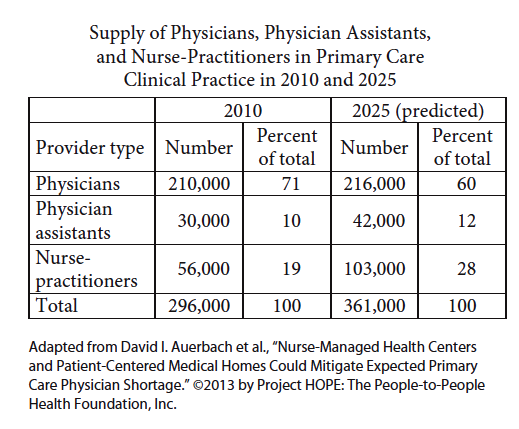 View Solution
View SolutionThe Physician Assistant Will See You Now
23 The term “paramedics” refers to health care workers who provide routine and clinical services.–––––––––––––––––––––––––––––––––––––––––––––––––––––––––––––––––––––––––––––––––––––––––––––––––––––– While the pressures of an aging population, insurance reforms, and health epidemics have increased demand for care, the supply of physicians is not expected to 24 keep pace.––––––––––– The Association of American Medical Colleges predicts a shortage of over 90,000 physicians by 2020, by 2025, that number could climb to more than 130,000. In some parts of the country, shortages are already a sad fact of life. A 2009 report by the Bureau of Health Professions notes that although a fifth of the US population lives in rural areas, less than a tenth of US physicians serves that population. Because a traditionalist response to the crisis— 25 amping up–––––––––––– medical-college enrollments and expanding physician training programs—is too slow and costly to address the near-term problem, alternatives are being explored. One promising avenue has been greater reliance on physician assistants (PAs).
26 By virtue of 27 there–––––– medical training, PAs can perform many of the jobs traditionally done by doctors, including treating chronic and acute conditions, performing minor 28 surgeries: and––––––––––––––– prescribing some medications. However, although well 29 compensated earning in 2012 a median annual salary of $90,930,––––––––––––––––––––––––––––––––––––––––––––––––––––––––––––––––––––– PAs cost health care providers less than do the physicians who might otherwise undertake these tasks. Moreover, the training period for PAs is markedly shorter than 30 those for–––––––––– physicians—two to three years versus the seven to eleven required for physicians.
Physician assistants already offer vital primary care in many locations. Some 90,000 PAs were employed nationwide in 2012. Over and above their value in partially compensating for the general physician shortage has been their extraordinary contribution to rural health care. A recent review of the scholarly literature by Texas researchers found that PAs lend cost-efficient, widely appreciated services in underserved areas. 31 In addition,––––––––––––– rural-based PAs often provide a broader spectrum of such services than do their urban and suburban counterparts, possibly as a consequence of the limited pool of rural-based physicians.
Increasingly, PAs and other such medical practitioners have become a critical complement to physicians. A 2013 RAND Corporation report estimates that while the number of primary care physicians will increase slowly from 2010 to 2025, the number of physician assistants and nurse-practitioners in primary care will grow at much faster rates. 32 Both by merit and from necessity, PAs are likely to greet more 33 patience than––––––––––––––– ever before.
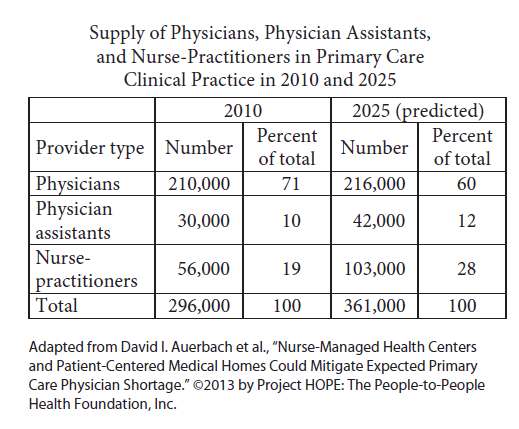 View Solution
View SolutionThe Physician Assistant Will See You Now
23 The term “paramedics” refers to health care workers who provide routine and clinical services.–––––––––––––––––––––––––––––––––––––––––––––––––––––––––––––––––––––––––––––––––––––––––––––––––––––– While the pressures of an aging population, insurance reforms, and health epidemics have increased demand for care, the supply of physicians is not expected to 24 keep pace.––––––––––– The Association of American Medical Colleges predicts a shortage of over 90,000 physicians by 2020, by 2025, that number could climb to more than 130,000. In some parts of the country, shortages are already a sad fact of life. A 2009 report by the Bureau of Health Professions notes that although a fifth of the US population lives in rural areas, less than a tenth of US physicians serves that population. Because a traditionalist response to the crisis— 25 amping up–––––––––––– medical-college enrollments and expanding physician training programs—is too slow and costly to address the near-term problem, alternatives are being explored. One promising avenue has been greater reliance on physician assistants (PAs).
26 By virtue of 27 there–––––– medical training, PAs can perform many of the jobs traditionally done by doctors, including treating chronic and acute conditions, performing minor 28 surgeries: and––––––––––––––– prescribing some medications. However, although well 29 compensated earning in 2012 a median annual salary of $90,930,––––––––––––––––––––––––––––––––––––––––––––––––––––––––––––––––––––– PAs cost health care providers less than do the physicians who might otherwise undertake these tasks. Moreover, the training period for PAs is markedly shorter than 30 those for–––––––––– physicians—two to three years versus the seven to eleven required for physicians.
Physician assistants already offer vital primary care in many locations. Some 90,000 PAs were employed nationwide in 2012. Over and above their value in partially compensating for the general physician shortage has been their extraordinary contribution to rural health care. A recent review of the scholarly literature by Texas researchers found that PAs lend cost-efficient, widely appreciated services in underserved areas. 31 In addition,––––––––––––– rural-based PAs often provide a broader spectrum of such services than do their urban and suburban counterparts, possibly as a consequence of the limited pool of rural-based physicians.
Increasingly, PAs and other such medical practitioners have become a critical complement to physicians. A 2013 RAND Corporation report estimates that while the number of primary care physicians will increase slowly from 2010 to 2025, the number of physician assistants and nurse-practitioners in primary care will grow at much faster rates. 32 Both by merit and from necessity, PAs are likely to greet more 33 patience than––––––––––––––– ever before.
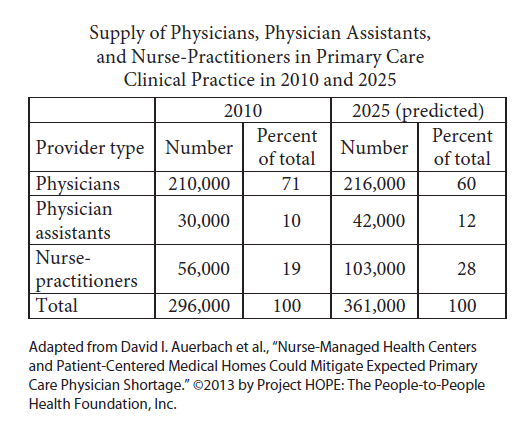 View Solution
View SolutionThe Physician Assistant Will See You Now
23 The term “paramedics” refers to health care workers who provide routine and clinical services.–––––––––––––––––––––––––––––––––––––––––––––––––––––––––––––––––––––––––––––––––––––––––––––––––––––– While the pressures of an aging population, insurance reforms, and health epidemics have increased demand for care, the supply of physicians is not expected to 24 keep pace.––––––––––– The Association of American Medical Colleges predicts a shortage of over 90,000 physicians by 2020, by 2025, that number could climb to more than 130,000. In some parts of the country, shortages are already a sad fact of life. A 2009 report by the Bureau of Health Professions notes that although a fifth of the US population lives in rural areas, less than a tenth of US physicians serves that population. Because a traditionalist response to the crisis— 25 amping up–––––––––––– medical-college enrollments and expanding physician training programs—is too slow and costly to address the near-term problem, alternatives are being explored. One promising avenue has been greater reliance on physician assistants (PAs).
26 By virtue of 27 there–––––– medical training, PAs can perform many of the jobs traditionally done by doctors, including treating chronic and acute conditions, performing minor 28 surgeries: and––––––––––––––– prescribing some medications. However, although well 29 compensated earning in 2012 a median annual salary of $90,930,––––––––––––––––––––––––––––––––––––––––––––––––––––––––––––––––––––– PAs cost health care providers less than do the physicians who might otherwise undertake these tasks. Moreover, the training period for PAs is markedly shorter than 30 those for–––––––––– physicians—two to three years versus the seven to eleven required for physicians.
Physician assistants already offer vital primary care in many locations. Some 90,000 PAs were employed nationwide in 2012. Over and above their value in partially compensating for the general physician shortage has been their extraordinary contribution to rural health care. A recent review of the scholarly literature by Texas researchers found that PAs lend cost-efficient, widely appreciated services in underserved areas. 31 In addition,––––––––––––– rural-based PAs often provide a broader spectrum of such services than do their urban and suburban counterparts, possibly as a consequence of the limited pool of rural-based physicians.
Increasingly, PAs and other such medical practitioners have become a critical complement to physicians. A 2013 RAND Corporation report estimates that while the number of primary care physicians will increase slowly from 2010 to 2025, the number of physician assistants and nurse-practitioners in primary care will grow at much faster rates. 32 Both by merit and from necessity, PAs are likely to greet more 33 patience than––––––––––––––– ever before.
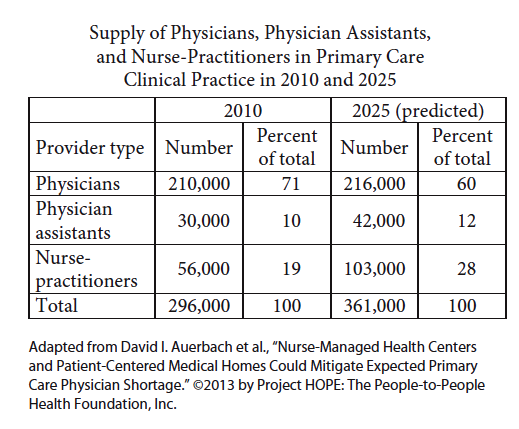 View Solution
View SolutionThe Physician Assistant Will See You Now
23 The term “paramedics” refers to health care workers who provide routine and clinical services.–––––––––––––––––––––––––––––––––––––––––––––––––––––––––––––––––––––––––––––––––––––––––––––––––––––– While the pressures of an aging population, insurance reforms, and health epidemics have increased demand for care, the supply of physicians is not expected to 24 keep pace.––––––––––– The Association of American Medical Colleges predicts a shortage of over 90,000 physicians by 2020, by 2025, that number could climb to more than 130,000. In some parts of the country, shortages are already a sad fact of life. A 2009 report by the Bureau of Health Professions notes that although a fifth of the US population lives in rural areas, less than a tenth of US physicians serves that population. Because a traditionalist response to the crisis— 25 amping up–––––––––––– medical-college enrollments and expanding physician training programs—is too slow and costly to address the near-term problem, alternatives are being explored. One promising avenue has been greater reliance on physician assistants (PAs).
26 By virtue of 27 there–––––– medical training, PAs can perform many of the jobs traditionally done by doctors, including treating chronic and acute conditions, performing minor 28 surgeries: and––––––––––––––– prescribing some medications. However, although well 29 compensated earning in 2012 a median annual salary of $90,930,––––––––––––––––––––––––––––––––––––––––––––––––––––––––––––––––––––– PAs cost health care providers less than do the physicians who might otherwise undertake these tasks. Moreover, the training period for PAs is markedly shorter than 30 those for–––––––––– physicians—two to three years versus the seven to eleven required for physicians.
Physician assistants already offer vital primary care in many locations. Some 90,000 PAs were employed nationwide in 2012. Over and above their value in partially compensating for the general physician shortage has been their extraordinary contribution to rural health care. A recent review of the scholarly literature by Texas researchers found that PAs lend cost-efficient, widely appreciated services in underserved areas. 31 In addition,––––––––––––– rural-based PAs often provide a broader spectrum of such services than do their urban and suburban counterparts, possibly as a consequence of the limited pool of rural-based physicians.
Increasingly, PAs and other such medical practitioners have become a critical complement to physicians. A 2013 RAND Corporation report estimates that while the number of primary care physicians will increase slowly from 2010 to 2025, the number of physician assistants and nurse-practitioners in primary care will grow at much faster rates. 32 Both by merit and from necessity, PAs are likely to greet more 33 patience than––––––––––––––– ever before.
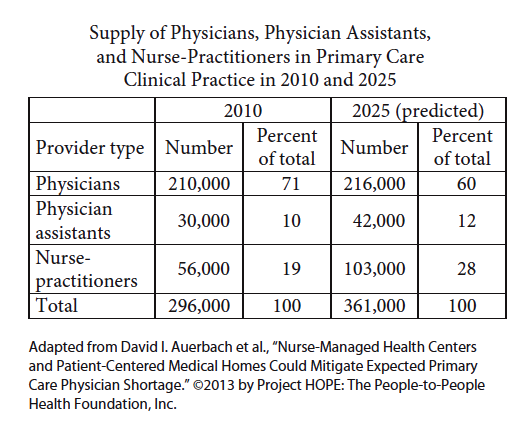
At this point, the writer is considering adding the following sentence.
Several factors argue in favor of such an expanded role.
Should the writer make this addition here?View Solution

